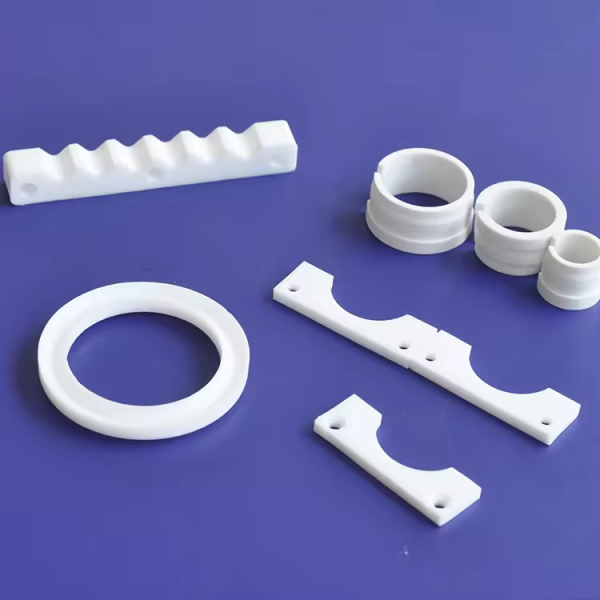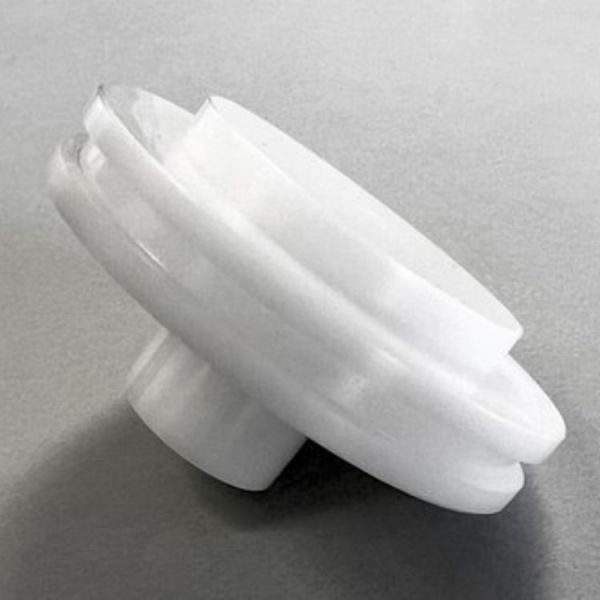What is fluoroplastic
Fluoroplastics are alkane polymers in which some or all of the hydrogen is replaced by fluorine. Fluoroplastics include: PTFE polytetrafluoroethylene (PTFE), PFA perfluoroalkoxyalkane polymers, FEP perfluoroethylene propylene copolymers, ETFE ethylene tetrafluoroethylene copolymers, ECTFE ethylene trichlorotrifluoroethylene copolymers, PVDF polyvinylidene fluoride, PCTFE polytrifluoroethylene, PVF polyvinylidene fluoride, and so on. Advantages of Fluoroplastics Fluoroplastics are produced by homopolymerization or copolymerization of fluorine-containing monomers, such as tetrafluoroethylene, hexafluoropropylene, chlorotrifluoroethylene, vinylidene fluoride, and fluoroethylene. Because fluoroplastics contain fluorine atoms in their molecular structure.
Therefore, they have many excellent properties:
1. Excellent chemical inertness, good chemical resistance;
2. Excellent abrasion resistance, very low coefficient of friction, and good non-stick properties;
3. Good electrical insulation properties;
4. Good resistance to high and low temperatures;
5. Very low water absorption, good gas barrier performance;
6. Excellent flame retardancy and high limiting oxygen index;
Fluorine plastic application areas Because of these excellent characteristics, fluorine plastic is widely used in the fields of defense and military industry, aerospace, chemical industry, semiconductor, electrical and electronic, construction, medical, automotive, electromechanical, metallurgy, petroleum, etc. It is an indispensable material for modern science and technology.

PTFE Polytetrafluoroethylene
PTFE raw material is white, high crystallinity, mostly powdered resin or concentrated dispersion. PTFE can not be molded by melt extrusion, injection molding and other molding methods, and is usually processed by high temperature sintering, paste extrusion, hydrostatic pressure, extrusion, impregnation, coating, etc. PTFE is particularly good in terms of corrosion resistance, very low coefficient of friction, extremely low surface tension, excellent electrical insulation, good resistance to high and low temperatures, and physiological inertia. PTFE accounts for 60~70% of the demand for fluoropolymer, and is widely used in the fields of anti-corrosion, sealing, insulation, anti-adhesion, human implantation, medical devices, and abrasion resistance.
FEP Perfluoroethylene Propylene Copolymer
FEP is the second fluoropolymer developed after PTFE, it is the modified material of PTFE, there are three kinds of granules, dispersions and paints.FEP melting point is lower than that of PFA, it has excellent coating ability, it can be processed by melt injection molding, extrusion blow molding, dispersions are for impregnation and sintering, and powders are for static spraying, molding, etc. FEP has excellent thermal stability, electrical properties, low abrasion resistance and long-term weather resistance, good softness and toughness.FEP is widely used in pipe and equipment lining, wire
Insulation Materials, cable sheathing, tubing, etc. PFA is a perfluoro-ethylene-propylene copolymer. FEP has excellent thermal stability, electrical properties, low abrasion resistance, and long-term weather resistance, and good flexibility and toughness.FEP is widely used in the lining of pipeline and equipment, wire insulation materials, cable sheathing, tubing and so on.
PFA Perfluoroalkoxyalkane Polymer
PFA is also known as soluble polytetrafluoroethylene, with high light transmittance and semi-transparent particles. the addition of fluoroalkyl vinyl ether (PAVE) in PFA reduces the melt viscosity, which gives PFA good melt processing performance, and it can be injection molded, extruded, and molded into a molding, but it has a higher melt viscosity than FEP, and the processing temperature is higher, the processing rate is smaller, and the corrosion of the thermal processing equipment is more serious. PFA retains most of the advantages of PTFE, such as heat resistance, corrosion resistance, flame retardant properties, electrical properties, etc., but the shortcoming is that the price of PFA is more expensive.PFA is commonly used in anti-corrosion and anti-aging coatings, special filtration fibers, chemical lining, fiber optic cable insulation, sealing, anti-adhesion, film, etc., widely used in construction, chemicals, semiconductors, medical, mechanical, electrical and aerospace industries.

PVDF Polyvinylidene fluoride
PVDF is the second largest fluoropolymer after PTFE in terms of production volume, and is usually supplied as a white powder or granule.PVDF has a very wide “processing window”, is easy to mold, and has a wide range of melting points and thermal decomposition temperatures. It can be molded using common thermoplastic processing methods such as injection, molding, extrusion, and blow molding. PVDF is not a perfluoropolymer, in the fluoroplastics have a relatively high hardness, good rigidity and creep resistance, it has fluorine resin heat, corrosion and weather resistance of the excellent performance, but also with the general resin is not the same as the molding and processing performance.PVDF has a very wide range of applications, such as semiconductor tubing and carrier, lithium-ion batteries, adhesives, corrosion-resistant fittings and accessories. PVDF is used in a wide range of applications, such as semiconductor piping and carriers, lithium-ion batteries, adhesives, corrosion-resistant fittings and coatings, aging-resistant films, cable sheaths and films, pharmaceutical filters, sensor pickups, and wire.
ETFE Ethylene Tetrafluoroethylene Copolymer
ETFE is obtained by modification of PTFE and is usually supplied in pellet or powder form, and is prepared in films with up to 95% transmittance.ETFE has a lower melting point than FEP, and has a lower melting point and a higher melt flow rate (MFR), making it easy to process by conventional melt extrusion techniques, as well as injection, compression, transfer, rotational, and blow molding processes.ETFE can also be molded through powder coatings and rotomolding, and has good adhesion to metals.ETFE is not a perfluoropolymer, and it retains PTFE's good adhesion to metals. It can also be molded by powder coating and rotational molding, and has good adhesion to metals.ETFE is not a perfluoropolymer, it retains the good heat resistance, chemical resistance, electrical insulation of PTFE, and the radiation resistance and mechanical strength are substantially improved, it is the toughest fluoroplastic, but the heat resistance of ETFE is relatively poor.ETFE is commonly used in corrosion-resistant linings and coatings for metal materials, construction films, Wiring cables, soft and hard pipelines, experimental equipment, chemical corrosion containers, and so on.

PCTFE Polychlorotrifluoroethylene
PCTFE is usually supplied in the form of granules, powder and suspension, and is milky white and semi-transparent.PCTFE melting point is lower than ETFE, although it can be processed by melt, it is relatively difficult to process due to the high viscosity of the melt, and the tendency of degradation which leads to the deterioration of the performance of the processed products. Can be molded by injection, extrusion, blown film molding, can also be made into suspensions used as anti-corrosion, electrical insulation coatings and films; PCTFE has a very high hardness, excellent gas and water vapor barrier properties, high hardness and creep resistance, but it will cause embrittlement due to radiation. PCTFE is mainly produced in semi-finished products sheet and rod used in the manufacture of chemical corrosion parts, suspensions for the manufacture of corrosion-resistant coatings and films, as well as low-temperature fluids used in the component materials. component materials used in fluids.
ECTFE Ethylene Trifluoroethylene Copolymer
ECTFE is usually supplied in the form of granules, powders and suspensions, and is milky white and semi-transparent.ECTFE can be melt-processed into granules for injection molding products, blow molded films, extruded sheets and rods, and other semi-finished products, and can also be rotomolded, coated and sprayed with powder to produce coatings and linings, and can be chemically foamed to make foam products.ECTFE has excellent chemical resistance, good transparency, smooth and self-cleaning, resistance to corrosion, and resistance to low-temperature fluids. ECTFE has excellent chemical resistance, good transparency, smooth and self-cleaning, good weather resistance and UV resistance, and good adhesion with EVA, suitable for photovoltaic power generation film.ECTFE is mainly used for coating and lining of all kinds of pipelines and tanks, photovoltaic film and microporous film; cables and cables; valves and pump body parts, etc..







